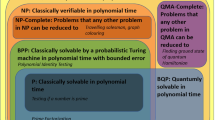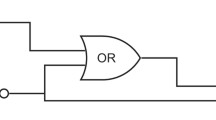Abstract
Tasked with the challenge to build better and better computers, quantum computing and classical computing face the same conundrum: the success of classical computing systems. Small quantum computing systems have been demonstrated, and intermediate-scale systems are on the horizon, capable of calculating numeric results or simulating physical systems far beyond what humans can do by hand. However, to be commercially viable, they must surpass what our wildly successful, highly advanced classical computers can already do. At the same time, those classical computers continue to advance, but those advances are now constrained by thermodynamics, and will soon be limited by the discrete nature of atomic matter and ultimately quantum effects. Technological advances benefit both quantum and classical machinery, altering the competitive landscape. Can we build quantum computing systems that out-compute classical systems capable of some \(10^{30}\) logic gates per month? This article will discuss the interplay in these competing and cooperating technological trends.
Similar content being viewed by others
Notes
Some care must be taken in comparing the exact feature sizes, as memory and logic chips are sometimes described using different terminology varying by a factor of two or so, and the actual feature size on chip may differ from the fabrication process, due to factors in the lithography and etching.
References
Bacon, D., van Dam, W.: Commun. ACM 53(2), 84 (2010). doi:10.1145/1646353.1646375
Feynman, R.P.: In: Hey, A.J.G. (ed.) Feynman and Computation. Westview Press, Boulder (2002)
L. Grover, in Proc. 28th Annual ACM Symposium on the Theory of Computation (1996), pp. 212–219. http://arXiv.org/quant-ph/9605043.
S. Hallgren, Journal of the ACM (JACM) 54(1) (2007).
Harrow, A.W., Hassidim, A., Lloyd, S.: Phys. Rev. Lett. 103(15), 150502 (2009). doi:10.1103/PhysRevLett.103.150502
Jordan, S.P., Lee, K.S.M., Preskill, J.: Science 336, 1130 (2012)
Magniez, F., Santha, M., Szegedy, M.: Proceedings of the sixteenth annual ACM-SIAM symposium on Discrete algorithms. Society for Industrial and Applied Mathematics 56, 1109–1117 (2005)
M. Mosca, Arxiv, preprint arXiv:0808.0369 (2008).
Shor, P.W.: Proceedings of 35th Symposium on Foundations of Computer Science, pp. 124–134. IEEE Computer Society Press, Los Alamitos (1994)
Whitfield, J., Biamonte, J., Aspuru-Guzik, A.: Mol. Phys. 109(5), 735 (2011)
D. Anderson, in 5th IEEE/ACM International Workshop on Grid Computing (2004), pp. 365–372. Available translated into Japanese at http://boinc.oocp.org/grid_paper_04.html
K. Asanovic, R. Bodik, B. Catanzaro, J. Gebis, P. Husbands, K. Keutzer, D. Patterson, W. Plishker, J. Shalf, S. Williams, et al., The landscape of parallel computing research: A view from Berkeley. Tech. rep., Technical Report UCB/EECS-2006-183, EECS Department, University of California, Berkeley (2006).
Coulouris, G., Dollimore, J., Kindberg, T.: Distributed Systems: Concepts and Design, 4th edn. Addison-Wesley, Menlo Park (2005)
Fox, G., Williams, R., Messina, P.: Parallel Computing Works!. Morgan Kaufmann Publication, San Francisco (1994)
Hennessy, J.L., Patterson, D.A.: Computer Architecture: A Quantitative Approach, 4th edn. Morgan Kaufman, San Francisco (2006)
Gustafson, J.L.: Commun. ACM 31(5), 532 (1988)
Devitt, S.J., Fowler, A.G., Stephens, A.M., Greentree, A.D., Hollenberg, L.C.L., Munro, W.J., Nemoto, K.: N. J. Phys. 11, 083032 (2009)
Jones, N.C., Van Meter, R., Fowler, A.G., McMahon, P.L., Kim, J., Ladd, T.D., Yamamoto, Y.: Phys. Rev. 2, 031007 (2012). doi:10.1103/PhysRevX.2.031007. http://link.aps.org/doi/10.1103/PhysRevX.2.031007
Van Meter, R., Ladd, T.D., Fowler, A.G., Yamamoto, Y.: Int. J. Quantum Inf. 8, 295 (2010)
M.G. Whitney, N. Isailovic, Y. Patel, J. Kubiatowicz, in Proc. 36th Annual International Symposium on Computer Architecture (2009).
A. Ambainis, A. Childs, B. Reichardt, in Foundations of Computer Science, 2007. FOCS’07. 48th Annual IEEE Symposium on (IEEE, 2007), pp. 363–372.
Childs, A., Cleve, R., Deotto, E., Farhi, E., Gutmann, S., Spielman, D.: Proceedings of the Thirty-Fifth Annual ACM Symposium on Theory of Computing, pp. 59–68. ACM, New York (2003)
O. Regev, in Foundations of Computer Science, 2002. Proceedings. The 43rd Annual IEEE Symposium on (IEEE, 2002), pp. 520–529.
A. Bocharov, K. Svore, Arxiv, preprint arXiv:1206.3223 (2012).
T.T. Pham, R. Van Meter, C. Horsman, arXiv preprint arXiv:1209/4139 (2012).
P. Selinger, arXiv:1212.6253 [quant-ph] (2012).
R.D. Van Meter III, Architecture of a quantum multicomputer optimized for Shor’s factoring algorithm. Ph.D. thesis, Keio University (2006). Available as arXiv:quant-ph/0607065.
R. Van Meter, C. Horsman, Communications of the ACM (2013). To appear.
ESIA, JEITIA, KSIA, TSIA, SIA, International technology roadmap for semiconductors. Tech. rep., ESIA and JEITIA and KSIA and TSIA and SIA (2012). http://public.itrs.net/.
G.E. Moore, Electronics 38(8) (1965).
N. Forbes, M. Foster, Computing in Science & Engineering pp. 18–19 (2003).
Kish, L.: Phys. Lett. A 305(3–4), 144 (2002)
I. Tuomi, First Monday 7(11–4) (2002).
R. Landauer, IBM J. of Research and Development 5(3), 183 (1961). Reprinted in IBM J. R.&D. Vol. 44 No. 1/2, Jan./Mar. 2000, pp. 261–269.
Meindl, J.D., Chen, Q., Davis, J.A.: Science 293, 2044 (2001)
Swade, D.: The Difference Engine: Charles Babbage and the Quest to Build the First Computer. Penguin, Baltimore (2002)
Riordan, M., Hoddeson, L.: Crystal Fire: the Birth of the Information Age. W. W. Norton, New York (1997)
Ieong, M., Doris, B., Kedzierski, J., Rim, K., Yang, M.: Science 306, 2057 (2004)
M. Lundstrom. Moore’s Law forever? (2003).
E.P. DeBenedictis, in Proc. 2nd conference on Computing Frontiers (ACM, 2005), pp. 391–402.
Bennett, C.H.: IBM J. Res. Develop. 17, 525 (1973)
C.H. Bennett, IBM J. of Research and Development 32(1) (1988). Reprinted in IBM J. R.&D. Vol. 44 No. 1/2, Jan./Mar. 2000, pp. 270–277.
Feynman, R.P.: Feynman Lectures on Computation. Addison Wesley, Menlo Park (1996)
Fredkin, E., Toffoli, T.: Int. J. Theor. Phys. 21, 219 (1982)
W.C. Athas, L.J. Svensson, in Proc. IEEE 1994 Workshop on Physics and Computing (IEEE, 1994).
Burignat, S., Vos, A.D.: Int. J. Electron. Telecommun. 58(3), 205 (2012)
M.P. Frank, Reversibility for efficient computing. Ph.D. thesis, MIT (1999).
Peres, A.: Phys. Rev. A 32(6), 3266 (1985)
Shende, V.V., Prasad, A.K., Markov, I.L., Hayes, J.P.: IEEE Trans. CAD 22(6), 710 (2003)
C. Vieri, M.J. Ammer, M. Frank, N. Margolus, T. Knight. A fully reversible asymptotically zero energy microprocessor. citeseer.ist.psu.edu/vieri98fully.html.
G. Bourianoff, IEEE Computer pp. 44–53 (2003).
G. Tseng, J. Ellenbogen. Toward nanocomputers (2001).
Beckman, R., Johnston-Halperin, E., Luo, Y., Green, J.E., Heath, J.R.: Science 310, 465 (2005)
A. DeHon, IEEE Trans. Nanotechnol. 2(1) (2003).
S.J. Aaronson, Limits on efficient computation in the physical world. Ph.D. thesis, U.C. Berkeley (2004).
Topol, A., Tulipe, D.L., Shi, L., Frank, D., Bernstein, K., Steen, S., Kumar, A., Singco, G., Young, A., Guarini, K., et al.: IBM J. Res. Develop. 50(4.5), 491 (2006)
M. Tsang, C.M. Caves, Phys. Rev. X 2, 031016 (2012). doi:10.1103/PhysRevX.2.031016. http://link.aps.org/doi/10.1103/PhysRevX.2.031016
K. Capek, R.U.R.: Rossum’s Universal Robots (1920).
Christensen, C.M.: The Innovator’s Dilemma: When New Technologies Cause Great Firms to Fail. Harvard Business Press, Cambridge (1997)
Author information
Authors and Affiliations
Corresponding author
Additional information
This work was supported by the Japan Society for the Promotion of Science (JSPS) through its “Funding Program for World-Leading Innovative R&D on Science and Technology (FIRST Program)”.
Rights and permissions
About this article
Cite this article
Van Meter, R. Quantum Computing’s Classical Problem, Classical Computing’s Quantum Problem. Found Phys 44, 819–828 (2014). https://doi.org/10.1007/s10701-014-9807-z
Received:
Accepted:
Published:
Issue Date:
DOI: https://doi.org/10.1007/s10701-014-9807-z




